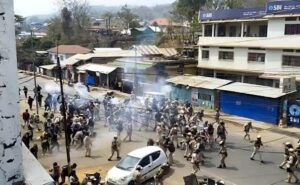
When we look closely at major conflicts around the world, one common thread emerges: the relentless struggle for a precious resource—land. Whether it’s the Middle East, Ireland, or closer to home in Jammu and Kashmir, these battles pit those who adhere to political borders against those who assert ethnic, sub-nationalistic, or nationalistic claims that transcend such boundaries.
Now, consider the Northeast of India, that slender piece of land protruding above Bangladesh, sandwiched between Tibet, China, Myanmar, and Bhutan. It serves as a captivating case study, illustrating how deeply entrenched mind-sets, unwavering historical and geographical perspectives, and intense competition combine to create seemingly insurmountable ethnic and demographic challenges.
The region’s reliance on central government patronage, often met with resentment, along with its physical and emotional detachment from the mainland, has given rise to a unique psyche characterized by dependence, bitterness, and a pervasive sense of alienation.
In this theatre of complex narratives, where histories collide and territorial claims entwine with identity, the struggle for land and belonging takes centre stage. It’s a drama where the actors are both victims and protagonists, caught in the throes of a relentless tug-of-war.
The North East of India, with its lush landscapes and vibrant cultures, is a microcosm of these global conflicts over land. It beckons us to delve deeper, to empathize with the human stories beneath the headlines, and to recognize that these issues are not abstract concepts but lived experiences.
As we contemplate the intricate tapestry of land disputes, let us remember that behind every border, every claim, there are people yearning for a sense of place and belonging. It’s a reminder that amidst the complexity, there is a shared humanity that transcends geography and politics.
In Manipur, a storm of inter-ethnic clashes between the Meitei and Kuki communities has raged since May 3, leaving devastation in its wake. Many lives lost, buildings razed to the ground, and more than 35,000 people displaced – these are the grim statistics of a conflict that shows no signs of abating. The government’s response has been predictable, mirroring tactics used in other troubled regions: military curfews, internet shutdowns, and a deployment troops with orders to shoot on sight in extreme cases.
But this isn’t an isolated incident. Manipur is just another chapter in India’s North-eastern tale of inter-ethnic strife, where the powerful exploit divisions among communities. Shocking videos depicting the sexual abuse and parading of 2 Kuki women and the resulting national outrage have finally brought this conflict to the forefront. However, beneath the sensational headlines lies a complex web of tensions that stretch far back in history. To truly achieve peace, we must understand that these divisions have been weaponized for decades, and any moves toward peacebuilding in the medium- to long-term will have to reckon with what has long been a weaponization of colonial fault lines.

Manipur is a battleground for at least four valley-based armed groups, numerous Naga factions, and nearly 30 Kuki insurgent organizations. The proliferation of these groups has created a “war within a war” scenario. The roots of this conflict trace back to the resistance against Manipur’s merger with India in 1949, a dispute that continues to simmer.
To quell this resistance, India enacted the controversial Armed Forces Special Powers Act in 1958, granting the military broad authority to “maintain public order” in “disturbed areas,” a label primarily applied to the Northeast and Jammu and Kashmir. Today, conflicting claims to ethnic homelands and armed insurgent groups defending these claims further complicate the situation.
Local politicians have reported intimidation by rival armed groups, turning elections into a charade overshadowed by “open intimidation” and violence. This has transformed the democratic process into a farce, a “democracy at gunpoint” in a region already on the edge.
One crucial aspect is the unregulated internet shutdown in Manipur, which persisted for over 80 days. While imposed to curb violence and misinformation, it also cut off essential information from reaching the public, exacerbating the crisis.
The Manipur conflict isn’t a spontaneous clash; it’s a symptom of deep-seated structural problems plaguing the state. It’s a reflection of unequal power dynamics among ethnic groups, driven more by aspirations to protect territories and resources than by political independence.
The social turmoil is intricately linked to changing land relations, affecting cultural systems, community land, and individual rights. Land and resource control lie at the heart of these conflicts, which are prevalent across the Northeast. For instance, in the 1990s, Manipur grappled with ethnic tensions between the Naga-Kuki, Meiteis-Pangal, and Paite-Kuki. The early 21st century saw a fierce political standoff between the Nagas and Meiteis over land and resources. It’s a stark reminder that behind the headlines and statistics, there are real people with real suffering.
While the future remains uncertain, it’s clear that the region must leverage its abundant natural resources. Greater autonomy, with a focus on traditional village systems but also embracing gender sensitivity and representation, could pave the way for a brighter future.

